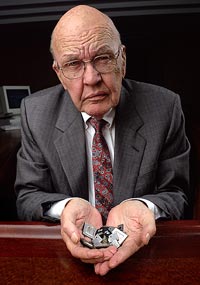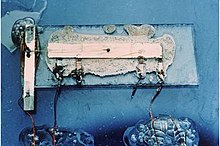Jack Kilby
Jack Kilby | |
|---|---|
 | |
| Born | November 8, 1923 |
| Died | June 20, 2005(aged 81) Dallas, Texas,U.S. |
| Alma mater | University of Illinois Urbana-Champaign University of Wisconsin–Madison |
| Awards | National Medal of Science(1969) IEEE Medal of Honor(1986) Charles Stark Draper Prize(1989) Computer Pioneer Award(1993) Kyoto Prize(1993) Harold Pender Award(2000) |
| Scientific career | |
| Fields | Physics,electrical engineering |
| Institutions | Texas Instruments |
Jack St. Clair Kilby(8 November 1923 - 20 June 2005) was an Americanelectrical engineerwho took part, along withRobert NoyceofFairchild Semiconductor,in the realization of the firstintegrated circuitwhile working atTexas Instruments(TI) in 1958.[1]: 22 He was awarded theNobel Prize in Physicson 10 December 2000.[2]
Kilby was also the co-inventor of thehandheld calculatorand thethermal printer,for which he had the patents. He also had patents for seven other inventions.[3]
Early life
[edit]Jack Kilby was born in 1923 in Jefferson City, Missouri, to Hubert and Vina Freitag Kilby.[4]Both parents had Bachelor of Science degrees from the University of Illinois. His father was a manager at a local utility company.[4]Kilby grew up and attended school inGreat Bend, Kansas,graduating from theGreat Bend High School.Today road signs at the entrances to the town commemorate his time there, and the Commons Area at Great Bend High School has been namedThe Jack Kilby Commons Area.
Kilby received hisBachelor of Sciencedegree from theUniversity of Illinois Urbana-Champaign,where he was an honorary member ofAcacia fraternity.In 1947, he received a degree inelectrical engineering.He earned hisMaster of Sciencein electrical engineering from theUniversity of Wisconsin–Madisonin 1950, while working atCentralab,a division ofGlobe-Unioncorporation inMilwaukee.
Career
[edit]Kilby was vital to theinvention of the integrated circuit.In mid-1958, as a newly employed engineer atTexas Instruments(TI), he did not yet have the right to a summer vacation. Kilby spent the summer working on the problem in circuit design that was commonly called the "tyranny of numbers",and he finally came to the conclusion that the manufacturing of circuit componentsen massein a single piece ofsemiconductormaterial could provide a solution. On September 12, he presented his findings to company's management, which includedMark Shepherd.He showed them a piece ofgermaniumwith anoscilloscopeattached, pressed a switch, and theoscilloscopeshowed a continuoussine wave,proving that hisintegrated circuitworked, and thus that he had solved the problem.[5]U.S. Patent 3,138,743for "Miniaturized Electronic Circuits", the first integrated circuit, was filed on February 6, 1959.[6]It was notable for having different components (transistors, diodes, resistors, capacitors, etc.) on one single substrate.[1]: 22 Along withRobert Noyce(who independently made a similar circuit a few months later), Kilby is generally credited as co-inventor of the integrated circuit.
Jack Kilby went on to pioneer military, industrial, and commercial applications of microchip technology. He headed teams that created the first military system and the first computer incorporating integrated circuits. He invented the handheld calculator (along withJerry MerrymanandJames Van Tassel[7]).
In 1970, he took a leave of absence from TI to work as an independent inventor. He explored, among other subjects, the use of silicon technology for generating electrical power from sunlight. From 1978 to 1984 he held the position of Distinguished Professor of Electrical Engineering atTexas A&M University.
In 1983, Kilby retired from Texas Instruments.
Legacy
[edit]
He died of cancer June 20, 2005 at the age of 81, inDallas, Texas.[8]
On December 14, 2005,Texas Instrumentscreated the Historic TI Archives. The Jack Kilby family donated his personal manuscripts and his personal photograph collection toSouthern Methodist University (SMU).The collection will be cataloged and stored at DeGolyer Library, SMU.
In 2008, the SMU School of Engineering, with the DeGolyer Library and the Library of Congress, hosted a year-long celebration of the 50th anniversary of the birth of the digital age with Kilby's Nobel Prize-winning invention of the integrated circuit. Symposia and exhibits examined the many ways in which technology and engineers shaped the modern world. Kilby held an honorary doctorate of science from SMU and was a longtime associate of SMU through the Kilby Foundation.
Awards and honors
[edit]A statue of Jack Kilby stands in Texas Instruments Plaza on the campus of The University of Texas at Dallas.[9]
Recognition of Kilby's outstanding achievements have been made by theInstitute of Electrical and Electronics Engineers(IEEE), including the election toIEEE Fellowin 1966, theIEEE David Sarnoff Awardin 1966,[10]co-recipient of the firstIEEE Cledo Brunetti Awardin 1978,[11]theIEEE Centennial Medalin 1984 and theIEEE Medal of Honorin 1986.[12]He was co-recipient of theFranklin Institute’sStuart Ballantine Medalin 1966.[13]In 1982 and 1989, he received the Holley Medal from theAmerican Society of Mechanical Engineers(ASME).[14]He was elected to member of theNational Academy of Engineering(NAE) in 1967[15]and received the Academy's Vladimir K. Zworykin Award in 1975. Kilby received the Golden Plate Award of theAmerican Academy of Achievementin 1970[16]and was co-recipient of the first NAE'sCharles Stark Draper Prizein 1989.[17]The Kilby Award Foundationwas founded in 1980 in his honor, and theIEEE Jack S. Kilby Signal Processing Medalwas created in 1995. He was elected to theAmerican Philosophical Societyin 2001.[18]
Kilby was awarded the Stibitz-Wilson Award from theAmerican Computer & Robotics Museumin 1997.[19]
Kilby is also the recipient of the America's most prestigious honors in science and engineering: theNational Medal of Sciencein 1969, and theNational Medal of Technologyin 1990. In 1982, he was inducted into theNational Inventors Hall of Fame.
In 1993, he was awarded theKyoto Prizeby the Inamori Foundation. He was awarded both the Washington Award, administered by the Western Society of Engineers and theEta Kappa NuVladimir Karapetoff Award in 1999. In 2000, Kilby was awarded theNobel Prize in Physicsfor his breakthrough discovery, and delivered his personal view of the industry and its history in his acceptance speech.[20]
Kilby was awarded nine honorary doctorate degrees from universities includingSouthern Methodist University,theUniversity of Miami,University of Illinois,University of Wisconsin–Madison,Texas A&M University,YaleandRochester Institute of Technology.TheNational Chiao Tung University(NCTU) inTaiwanawarded Kilby with a certificate of Honorary Professorship in 1998.
The Kilby Labs, TI's research laboratory forsiliconmanufacturing andintegrated circuitdesign, is named after him.
The Jack Kilby Computer Centre at theMerchistonCampus ofEdinburgh Napier UniversityinEdinburghis also named in his honor.[21]
Kilby patents
[edit]- U.S. patent 2,892,130Plug-in Circuit Units,filed December 1953, issued June 1959, assigned to Globe-Union, Inc.
- U.S. patent 3,072,832Semiconductor Structure Fabrication,filed May 1959, issued January 1963
- U.S. patent 3,115,581Miniature Semiconductor Integrated Circuit,filed May 1959, issued December 1963
- U.S. patent 3,138,721Miniature Semiconductor Network Diode and Gate,filed May 1959, issued June 1964
- U.S. patent 3,138,743Miniaturized Electronic Circuits,filed February 6, 1959, issued June, 1964
- U.S. patent 3,138,744Miniaturized Self-contained Circuit Modules,filed May 1959, issued June 1964
- U.S. patent 3,435,516Semiconductor Structure Fabrication,filed May 1959, issued April 1969
- U.S. patent 3,496,333Thermal Printer,filed October 1965, issued February 1970
- U.S. patent 3,819,921Miniature Electronic Calculator,originally filed September 1967, issued June 1974
See also
[edit]References
[edit]- ^abHarper, Charles A., ed. (2004).Electronic materials and processes handbook.McGraw-Hill handbooks (3 ed.). McGraw-Hill.ISBN9780071402149.
- ^The Nobel Prize in Physics 2000
- ^"The Chip that Jack Built".IT Invention.Retrieved27 May2014.
- ^ab"Jack St. Clair Kilby - Kansapedia - Kansas Historical Society".
- ^Das, Saswato R. (2008-09-19)."Opinion: The chip that changed the world".The New York Times.
- ^"The Nobel Prize in Physics 2000".Nobel Foundation.Retrieved2011-07-14.
- ^Stengle, Jamie (7 March 2019)."Jerry Merryman, co-inventor of handheld electronic calculator, dies at 86".The Washington Post.Retrieved8 March2019.
- ^John Markoff (June 22, 2005)."Jack S. Kilby, an Inventor of the Microchip, Is Dead at 81".New York Times.Retrieved9 January2022.
- ^"What's the Story? The TI Plaza Statue".
- ^"IEEE David Sarnoff Award Recipients"(PDF).IEEE.Archived fromthe original(PDF)on June 19, 2010.RetrievedDecember 6,2011.
- ^"IEEE Cledo Brunetti Award Recipients"(PDF).IEEE.RetrievedDecember 6,2011.
- ^"IEEE Medal of Honor Recipients"(PDF).IEEE. Archived fromthe original(PDF)on 2015-04-22.RetrievedDecember 6,2011.
- ^"Franklin Laureate Database – Stuart Ballantine Medal 1966 Laureates".Franklin Institute.Archived fromthe originalon 2012-12-10.RetrievedDecember 6,2011.
- ^"Holley Medal".American Society of Mechanical Engineers.RetrievedDecember 6,2011.
- ^"NAE Members Directory – Mr. Jack S. Kilby".National Academy of Engineering.RetrievedDecember 6,2011.
- ^"Golden Plate Awardees of the American Academy of Achievement".achievement.org.American Academy of Achievement.
- ^"Recipients of The Charles Stark Draper Prize".National Academy of Engineering.RetrievedDecember 6,2011.
- ^"APS Member History".search.amphilsoc.org.Retrieved2021-10-19.
- ^"Stibitz-Wilson Awards 1997".
- ^Nobel Prize acceptance speech
- ^"School of Computing – Facilities & Resources".Edinburgh Napier University.RetrievedJuly 24,2012.
References bibliography
[edit]- Berlin, LeslieThe man behind the microchip: Robert Noyce and the invention of Silicon ValleyPublisher Oxford University Press US, 2005ISBN0-19-516343-5
- Lécuyer, Christophe.Making Silicon Valley: Innovation and the Growth of High Tech, 1930-1970Published by MIT Press, 2006.ISBN0262122812
- Nobel lectures,World Scientific Publishing Co., Singapore, 2000.
External links
[edit] Media related toJack Kilbyat Wikimedia Commons
Media related toJack Kilbyat Wikimedia Commons
- "Jack St. Clair Kilby: A Man of Few Words",biography by Ed Millis.
- "From concept to cosmos: How Jack Kilby's integrated circuit transformed the electronics industry",biography by Texas Instruments.
- "Jack Kilby, Touching Lives on Micro and Macro Scales"byT.R. Reid,The Washington Post(June 2005).
- Jack S. Kilby Patents
- "Tribute to Jack Kilby",Dream 2047, November 2005
- 1923 births
- 2005 deaths
- Engineers from Missouri
- Engineers from Texas
- American inventors
- People from Jefferson City, Missouri
- Physicists from Missouri
- Scientists from Missouri
- Grainger College of Engineering alumni
- University of Wisconsin–Madison College of Engineering alumni
- American electronics engineers
- Nobel laureates in Physics
- American Nobel laureates
- IEEE Medal of Honor recipients
- National Medal of Technology recipients
- National Medal of Science laureates
- Texas Instruments people
- Deaths from cancer in Texas
- Amateur radio people
- Draper Prize winners
- Scientists from Kansas
- IEEE Centennial Medal laureates
- Fellows of the IEEE
- Members of the United States National Academy of Engineering
- Kyoto laureates in Advanced Technology
- Members of the American Philosophical Society
